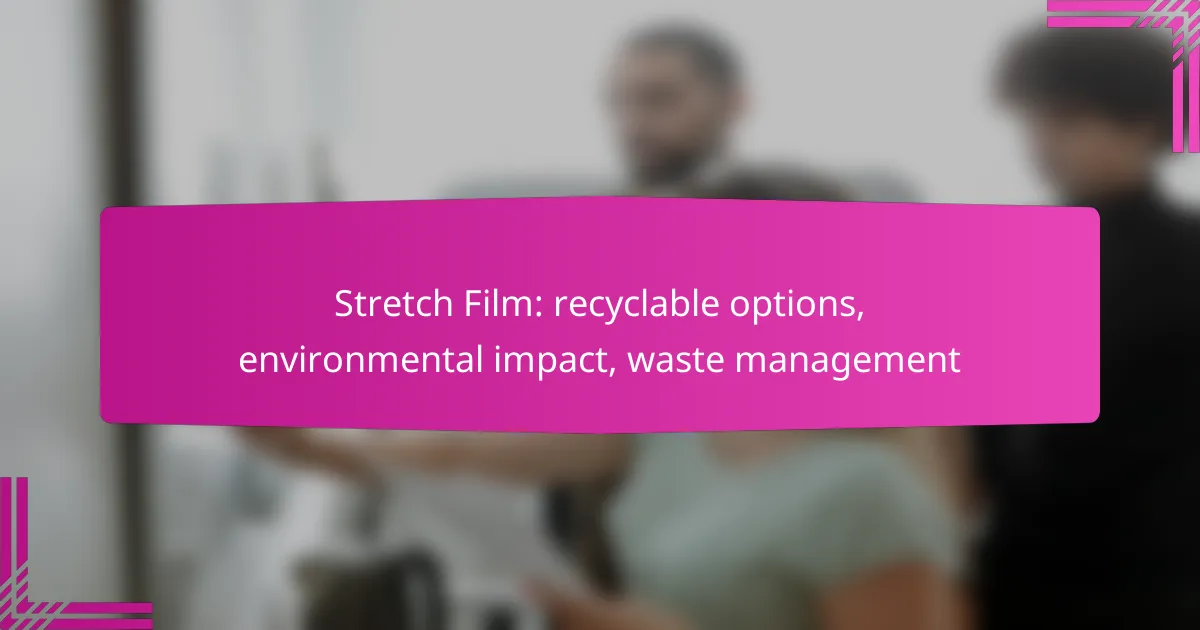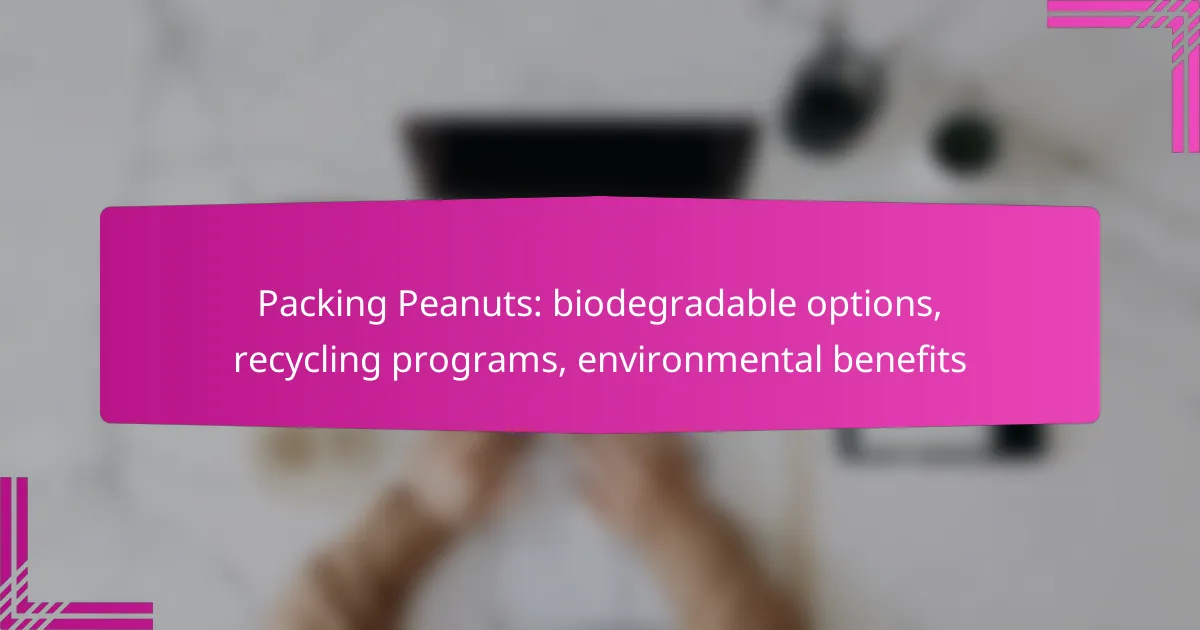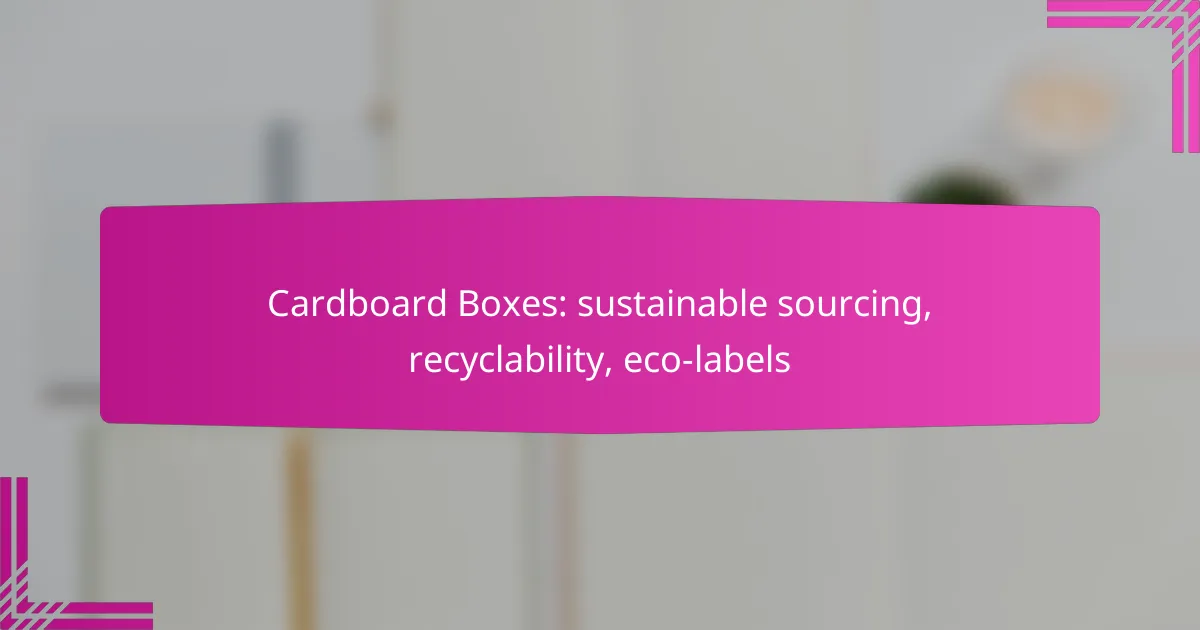Stretch film plays a crucial role in packaging and shipping, but its environmental impact raises significant concerns. With recyclable options like biodegradable and compostable varieties emerging in New Zealand, there is potential to mitigate these effects. Implementing effective waste management strategies is essential to promote sustainability and reduce the ecological footprint associated with traditional stretch film usage.

What are recyclable options for stretch film in New Zealand?
In New Zealand, recyclable options for stretch film include biodegradable, recycled polyethylene, and compostable varieties. These alternatives aim to reduce environmental impact while maintaining functionality in packaging and shipping.
Biodegradable stretch film
Biodegradable stretch film is designed to break down more quickly than traditional plastic when exposed to environmental conditions. This type of film typically incorporates additives that enhance its degradation process, making it a more eco-friendly choice for temporary packaging needs.
When selecting biodegradable stretch film, consider its intended use and disposal method. While it can reduce landfill waste, it still requires specific conditions to decompose effectively, such as moisture and microbial activity.
Recycled polyethylene options
Recycled polyethylene stretch film is made from post-consumer plastic waste, offering a sustainable alternative to virgin materials. This option helps divert plastic from landfills and reduces the demand for new plastic production.
When using recycled polyethylene, check for certifications that confirm the percentage of recycled content. Many suppliers in New Zealand provide options that contain varying levels of recycled material, typically ranging from 30% to 100%.
Compostable stretch film
Compostable stretch film is designed to break down in composting environments, turning into organic matter rather than plastic waste. This type of film is often made from plant-based materials, making it suitable for industrial composting facilities.
To ensure effective composting, verify that the film meets relevant compostability standards, such as AS 4736 in New Zealand. Proper disposal in a commercial composting facility is crucial, as home composting may not provide the necessary conditions for breakdown.
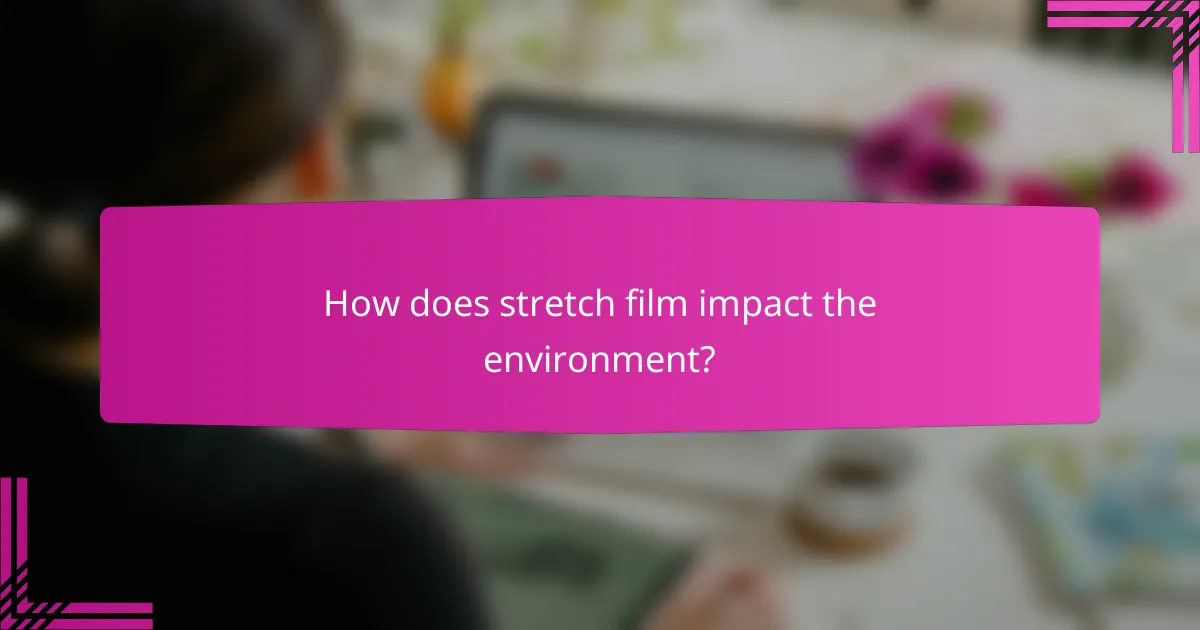
How does stretch film impact the environment?
Stretch film significantly affects the environment through its production processes, waste management challenges, and potential harm to ecosystems. Its reliance on non-renewable resources and the difficulties in recycling contribute to its environmental footprint.
Carbon footprint of production
The production of stretch film generates a substantial carbon footprint, primarily due to the extraction and processing of fossil fuels. Manufacturing processes can emit greenhouse gases, contributing to climate change. Efforts to reduce this impact include using recycled materials and adopting energy-efficient technologies.
For instance, companies that utilize post-consumer recycled (PCR) plastics in their stretch film can lower their carbon emissions by a notable percentage. Transitioning to renewable energy sources during production can further mitigate environmental harm.
Effects on marine life
Stretch film poses a significant threat to marine life when it ends up in oceans and waterways. Marine animals can ingest plastic debris or become entangled, leading to injury or death. The breakdown of plastic into microplastics exacerbates the issue, as these tiny particles can enter the food chain.
Efforts to address these effects include promoting proper waste disposal and encouraging the use of biodegradable alternatives. Public awareness campaigns can also help reduce littering and improve recycling rates.
Landfill contributions
Stretch film contributes to landfill waste, where it can take hundreds of years to decompose. This accumulation not only occupies valuable space but also poses risks of leaching harmful chemicals into the soil and groundwater. Many landfills are not equipped to handle plastic waste effectively.
To combat this issue, businesses and consumers should prioritize recycling stretch film whenever possible. Some retailers offer take-back programs for plastic film, allowing for proper recycling and reducing landfill contributions.

What are effective waste management strategies for stretch film?
Effective waste management strategies for stretch film include recycling programs, industrial waste reduction techniques, and consumer education initiatives. These approaches aim to minimize environmental impact and promote sustainable practices in handling stretch film waste.
Recycling programs in New Zealand
In New Zealand, several recycling programs focus on stretch film, encouraging businesses and consumers to participate in proper disposal. Local councils often collaborate with waste management companies to provide designated drop-off points for plastic films, including stretch film.
Recyclable stretch film is typically collected and processed into new products, reducing landfill waste. It’s essential for participants to ensure that the film is clean and free from contaminants, as this significantly affects the recycling process.
Industrial waste reduction techniques
Industries can adopt various waste reduction techniques to manage stretch film more effectively. Implementing practices such as optimizing packaging processes and using reusable pallets can significantly decrease the amount of stretch film used.
Another effective method is to switch to biodegradable or recyclable stretch films, which can mitigate environmental impact. Regular audits of packaging materials can help identify areas for improvement and reduce overall waste generation.
Consumer education initiatives
Consumer education initiatives play a crucial role in promoting responsible stretch film disposal. Programs aimed at informing the public about the importance of recycling and proper waste management can lead to higher participation rates in recycling efforts.
Workshops, informational campaigns, and community events can help raise awareness about the environmental impact of stretch film and encourage consumers to choose recyclable options. Providing clear guidelines on how to recycle stretch film effectively can further enhance these initiatives.

What criteria should be considered when choosing stretch film?
When selecting stretch film, consider factors such as material sustainability, cost-effectiveness, and performance characteristics. These criteria will help ensure that the chosen film meets both environmental standards and operational needs.
Material sustainability
Material sustainability refers to the environmental impact of the stretch film’s production and disposal. Look for films made from recycled materials or those that are fully recyclable to minimize waste. Some manufacturers offer biodegradable options that break down more easily in landfills.
Check for certifications like the Global Recycling Standard (GRS) or the Forest Stewardship Council (FSC) to ensure the materials used are sustainably sourced. This can enhance your brand’s image and appeal to eco-conscious consumers.
Cost-effectiveness
Cost-effectiveness involves evaluating the price of stretch film relative to its performance and longevity. While cheaper films may save money upfront, they might require more frequent replacements, leading to higher long-term costs. Aim for a balance between initial investment and durability.
Consider bulk purchasing options, which can reduce per-unit costs. Additionally, assess the total cost of ownership, including disposal fees and potential environmental compliance costs, to make a well-informed decision.
Performance characteristics
Performance characteristics include the film’s strength, stretchability, and clarity. A good stretch film should provide adequate load stability and protection during transportation. Look for films that can stretch significantly without tearing, as this can lead to better wrapping efficiency.
Evaluate specific performance metrics such as puncture resistance and cling properties. Testing different films in real-world conditions can help identify the best option for your needs, ensuring that it meets both operational and environmental standards.

How can businesses improve stretch film recycling rates?
Businesses can enhance stretch film recycling rates by fostering collaborations with recycling facilities, establishing take-back programs, and training employees on effective waste segregation. These strategies not only promote sustainability but also help in reducing the environmental impact of plastic waste.
Partnerships with recycling facilities
Forming partnerships with local recycling facilities is crucial for improving stretch film recycling. Businesses should identify nearby facilities that accept stretch film and negotiate agreements for regular collection and processing. This collaboration ensures that the materials are properly recycled rather than ending up in landfills.
Additionally, businesses can work with recycling facilities to understand their specific requirements for accepting stretch film. This may include cleaning protocols or material specifications, which can help streamline the recycling process and increase the volume of recycled materials.
Implementing take-back programs
Take-back programs allow businesses to collect used stretch film from customers and employees, encouraging responsible disposal. By offering incentives such as discounts or rewards for returning used film, companies can motivate participation and reduce waste.
These programs should be clearly communicated to all stakeholders, outlining how and where to return the stretch film. Providing convenient drop-off locations or scheduled pickups can significantly enhance participation rates and ensure that more materials are recycled.
Employee training on waste segregation
Training employees on proper waste segregation is essential for maximizing recycling efforts. Staff should be educated on how to identify recyclable stretch film and the importance of keeping it separate from general waste. This can be achieved through workshops, informational materials, and visual aids placed near waste disposal areas.
Regular refresher courses can help maintain awareness and reinforce best practices. By fostering a culture of sustainability within the workplace, businesses can significantly improve their stretch film recycling rates and contribute positively to waste management efforts.
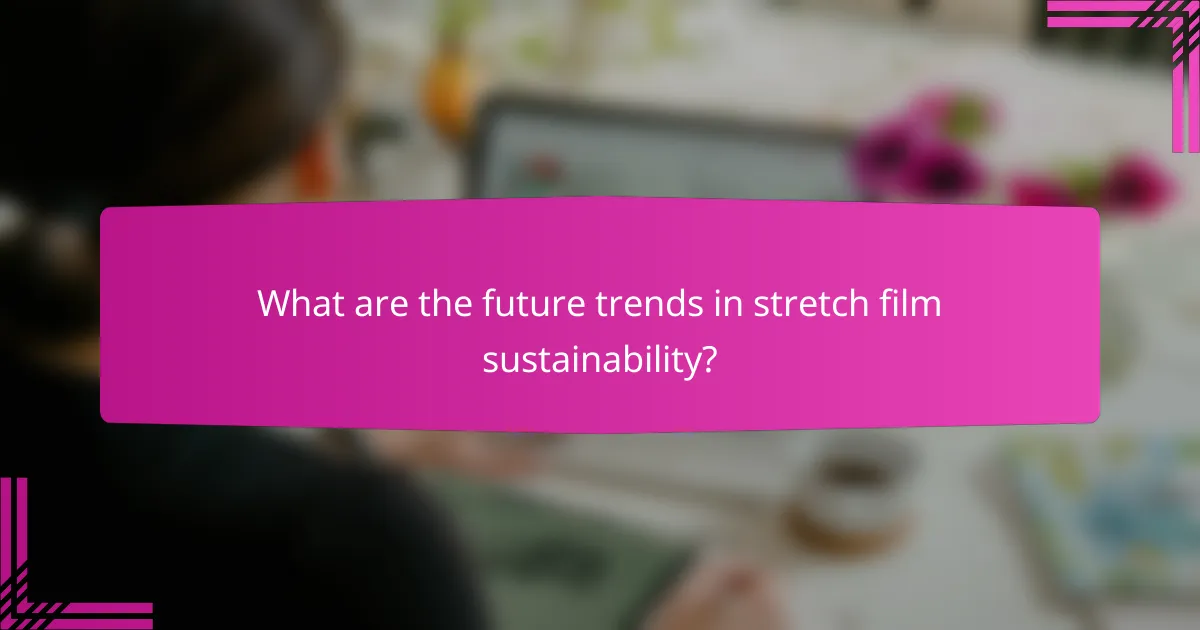
What are the future trends in stretch film sustainability?
The future of stretch film sustainability is increasingly focused on reducing environmental impact through innovative materials and recycling practices. Companies are exploring biodegradable options and improved waste management strategies to minimize plastic pollution.
Innovations in biodegradable materials
Biodegradable materials for stretch film are gaining traction as manufacturers seek to reduce reliance on traditional plastics. These materials often break down more quickly in natural environments, which can significantly lessen long-term waste accumulation.
Common biodegradable options include films made from plant-based sources such as cornstarch or polylactic acid (PLA). While these materials can offer similar performance to conventional stretch films, their degradation rates can vary based on environmental conditions, making proper disposal crucial.
When considering biodegradable stretch films, it’s essential to check for certifications that ensure they meet industry standards for compostability. Additionally, businesses should evaluate the cost implications, as biodegradable options can sometimes be more expensive than traditional films, but the environmental benefits may justify the investment.
